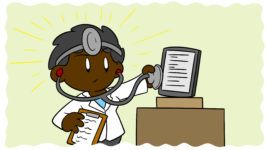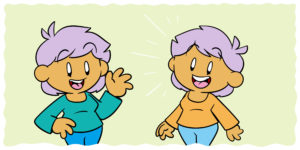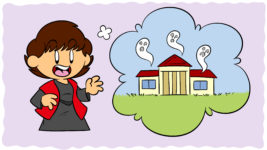Every great piece of writing needs both an author and an editor. That’s because writing isn’t just a process of creation, but also of modification and even controlled destruction. Exceptional writing shines brighter when it isn’t hampered by supporting more mediocre content, and most writers will find the quality of their work improves when they’re challenged to make changes or address specific concerns.
Despite this, it’s true that not every author has absolute and constant access to an editor. For this large segment of authors, the answer is to learn how to edit their own work in a way which replicates some of the vital input of another person.
It’s important to stress that learning to edit your own work does not replace the function of a good editor. Instead, the intent is make this eventual, necessary consultation as focused as possible. By becoming editors of their own work, writers allow professional editors to spend all their time focusing on the things they are uniquely suited to address. For example, an editor can help you develop your character arcs a lot more if you’ve already cut out all the unnecessary scenes.
The objective editor
Learning to edit your own work is about forcing yourself to be objective. Much of an editor’s job is in addressing problems that the author can’t or won’t see. Present from the conception of every story and character, authors are often blind to problems that a less familiar eye can instantly recognize. While it’s impossible to disregard this kind of blindness entirely, authors can assess their work far more objectively than they might initially realize.
The secret to being a successful author-editor is the ability to compartmentalize your roles – to have an ‘author’ hat and an ‘editor’ hat and to know when each is appropriate. The idea that authors should ‘write drunk, edit sober’ is often dubiously linked to Ernest Hemingway. Whether he said it or not, the metaphor holds; great authors need to be able to write with creative abandon but edit methodically and logically.
The successful author-editor compartmentalizes their roles.Click To TweetEditing is, by and large, a mechanical process. Yes there’s a unique creativity to it, but the majority of editing work is in looking at how the story is put together, and how its parts can be shifted around or replaced to benefit the whole. This is great news for writers who want to increase their editorial ability, since it means there is a science to editing that they can learn. And, like any scientific endeavor, it begins with investigation.
Secret 1: Identify your style
Clearly, it’s impossible to immediately identify the aspects of a story to which, as the author, you might be critically blind. How are you supposed to know if you write bad dialogue?
The answer is in going back a step and identifying your particular style of writing. Are you an action person, or do you shy away from physical scenes? Do you enjoy dialogue, are you prone to long descriptions, how do you prefer to begin a story?
The answer to each of these questions gives you a greater idea of your blind spots, and the more you ask, the more objectively you can view your own writing. If you enjoy something then be on the lookout for overindulgence or clear patterns (common phrases in dialogue, for example), and if you dislike a certain type of writing, then make sure it’s either great where it appears, or its function in the story is still served without it – if inter-character tension isn’t released in an action scene, then make sure it’s addressed elsewhere.
Write down all the aspects of your writing you can think of, and then branch off them to list possible issues that type of writing could create. This will help divorce the possible flaws from the actual work, and get you thinking objectively about issues you’re likely to encounter.
If you’re struggling to identify the issues that might come with your kind of writing then find a few critically panned books in a similar style (you might have to grab a few to cover different aspects of your own style). While their mistakes won’t be your own, they will show you the type of errors that a particular style invites.
Now, as an editor, you don’t have to think of the problems that might be in your work, just the things you need to check for in the style you’ve identified. It’s much harder to justify a poor choice than it is to ignore one. Of course there are still certain passages that could escape your editor’s pen…
Secret 2: Isolate your favorite parts
The true meaning of William Faulkner’s quote, ‘In writing, you must kill all your darlings’, is hotly contested. Some suggest it’s literal: kill the characters you like most, while others hold that it’s about applying particular editorial rigor to passages you love.
The latter is certainly more widely applicable. A universal pitfall for authors, there are few things deadlier than a writer’s blindness for a phrase, sentence, paragraph, or even chapter that they love. Often it’s one of the first things they thought of, the story’s original raison d’être that has failed to evolve with the rest of the work.
Beloved passages (especially early creations) are a common blindspot for authors. Click To TweetIronically, the beloved passage ends up being not just bad, but harmful to the rest of the story, as better writing is warped to accommodate its presence. These poisonous darlings are often invisible to an author. The only solution is to recognize this fact, and apply particular attention to the parts of your story that you like the most.
In the best case scenario, this means interrogating whether a passage really is brilliant, or whether it’s just special to you. In the worst case it means recognizing that you cannot be objective about quality, and making sure an editor pays particular attention to the passage in question.
Often the answer will be to lose your favorite parts, but then for a dedicated author-editor that’s going to be a common refrain.
Secret 3: Strive for brevity
The idiom ‘less is more’ is commonly attributed to Robert Browning’s poem ‘Andrew del Sarto’, and is so self-evidently true that many people have never considered that someone has to have coined it.
This maxim is the corner-stone of an objective author-editor’s work, and yet again good editorial practice comes from suppressing authorial ego. The urge as an author will always be to change a problematic section, but often a story would benefit more from outright removal.
As I mentioned at the beginning, great writing is at its best when it isn’t being forced to support other content. This means that a good editor’s question isn’t ‘can I make this work?’, it’s ‘can I cut this?’
A good editor’s question isn’t ‘can I make this work?’, it’s ‘can I cut this?’Click To TweetEmbracing this way of thinking severs the tie between your authorial and editorial mindsets. It stops you from making excuses for subpar writing because those excuses have no place in the equation. Can it be cut? If yes, then cut it. If no, then know why not.
Secret 4: Justify, justify, justify
The final step in minimizing your bias and behaving as an objective editor is to formalize your justifications. Justifications are the reasons you give yourself for doing things a certain way. The problem is that when you already want to do things a certain way, it’s easy to accept a fleeting and incomplete justification as the real deal.
Say you want to keep a scene that has a few problems. It’s not enough to just like it; try to reason out, and write down, exactly why it deserves to stay. What does it do for the story? Can that service be provided by another section, or be provided in an easier or better way? Remember that a good editor favors cutting the unnecessary.
When editing your own work it can be helpful to create an antagonistic script; to have some pre-prepared aggressive questions that you have to answer. Doing so before you encounter a problem means that you’ll have an objective critical system to fall back on, and your own bias about the particular passage will be less persuasive.
Being your own best enemy
The techniques above are based on the concept of complete separation between authorial and editorial behavior. You write, you edit, you write, you edit, and eventually you reach a point where you’ve done everything you can.
What’s important to note is that you can only edit once you’ve created. Challenging a passage is only useful once the passage exists – second-guessing yourself mid-sentence won’t lead to better writing, just confusion and frustration.
Remember, also, that editing your own work isn’t about being harsh with yourself (though that is a component); it’s about being fair to yourself. A lot of the stuff you write will be great, and the editorial process will be about making yourself sure of that fact. Be sure to note when something passes the test, and you’ll quickly realize that the ticks far outnumber the crosses.
For more on the self-editing process check out Here’s How A Tortoise Can Help You Finally Finish Your Novel and 4 Simple Tips To Catch More Errors When Proofreading, or try Why Beta Readers Are Vital To Your Success and Is Now The Time For An Alpha Reader? for the next steps in making sure your work is in the best possible condition.
Do you struggle with self-editing, or do you have some tips for fellow writers? Let me know in the comments.





